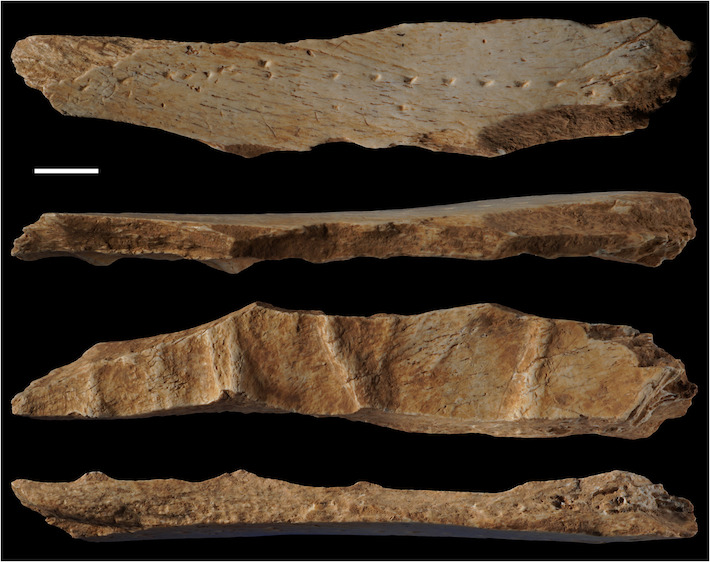 BORDEAUX, FRANCE—According to a Haaretz report, Homo sapiens may have used a 39,600-year-old animal bone found at a Paleolithic site in Catalonia, Spain, as a punchboard to poke holes in leather hides. The bone, which likely came from the hip of a large mammal such as a horse or aurochs, is indented with 28 aligned puncture marks, some of them equidistant from each other. An international team of researchers studied the marks and, to help determine if they were made by humans, experimented with piercing leather with stone and bone tools. Their results suggest that even before the advent of the needle, early Homo sapiens laid leather pieces on the flat bone to poke holes in hides using a bone awl or similar pointed implements. The perforated hides could then be stitched into clothing with cords or threads. “We have a few awls or pointed stone tools here and there, but we basically are still in the dark regarding the techniques to make fitted clothes,” said archaeologist Luc Doyon of the University of Bordeaux. “Now for the first time we're documenting a technique that's used by traditional societies and cobblers to this very day.” Read the original scholarly article about this research in Science Advances. To read about another early leatherworking tool uncovered in Morocco, go to "Earliest Leatherworkers," one of ARCHAEOLOGY's Top 10 Discoveries of 2021.
BORDEAUX, FRANCE—According to a Haaretz report, Homo sapiens may have used a 39,600-year-old animal bone found at a Paleolithic site in Catalonia, Spain, as a punchboard to poke holes in leather hides. The bone, which likely came from the hip of a large mammal such as a horse or aurochs, is indented with 28 aligned puncture marks, some of them equidistant from each other. An international team of researchers studied the marks and, to help determine if they were made by humans, experimented with piercing leather with stone and bone tools. Their results suggest that even before the advent of the needle, early Homo sapiens laid leather pieces on the flat bone to poke holes in hides using a bone awl or similar pointed implements. The perforated hides could then be stitched into clothing with cords or threads. “We have a few awls or pointed stone tools here and there, but we basically are still in the dark regarding the techniques to make fitted clothes,” said archaeologist Luc Doyon of the University of Bordeaux. “Now for the first time we're documenting a technique that's used by traditional societies and cobblers to this very day.” Read the original scholarly article about this research in Science Advances. To read about another early leatherworking tool uncovered in Morocco, go to "Earliest Leatherworkers," one of ARCHAEOLOGY's Top 10 Discoveries of 2021.
How Did Homo Sapiens Make Clothes?
